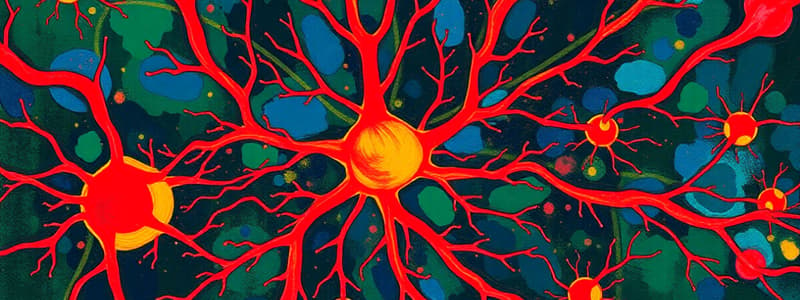Podcast
Questions and Answers
What is the rate-limiting step in the formation of norepinephrine?
What is the rate-limiting step in the formation of norepinephrine?
- Decarboxylation of DOPA to dopamine
- Hydroxylation of tyrosine to DOPA (correct)
- Storage of dopamine in synaptic vesicles
- Transport of tyrosine into the neuron
What happens to dopamine after its synthesis in the adrenergic neuron?
What happens to dopamine after its synthesis in the adrenergic neuron?
- It is broken down into byproducts.
- It is converted directly into norepinephrine.
- It is released into the synaptic gap immediately.
- It is transported into synaptic vesicles. (correct)
Which enzyme is responsible for converting tyrosine to DOPA?
Which enzyme is responsible for converting tyrosine to DOPA?
- Tyrosine hydroxylase (correct)
- DOPA decarboxylase
- Tyrosine decarboxylase
- Aromatic l-amino acid decarboxylase
What is the role of reserpine in the context of adrenergic neurons?
What is the role of reserpine in the context of adrenergic neurons?
Which of the following steps is NOT involved in neurotransmission at adrenergic neurons?
Which of the following steps is NOT involved in neurotransmission at adrenergic neurons?
What percentage of norepinephrine is released by the adrenal medulla?
What percentage of norepinephrine is released by the adrenal medulla?
What triggers the release of norepinephrine from neurons?
What triggers the release of norepinephrine from neurons?
What mechanism is utilized by norepinephrine to initiate intracellular events in the effector cell?
What mechanism is utilized by norepinephrine to initiate intracellular events in the effector cell?
Which drug can inhibit the release process of norepinephrine?
Which drug can inhibit the release process of norepinephrine?
What happens to norepinephrine after it is released into the synaptic space?
What happens to norepinephrine after it is released into the synaptic space?
What is the primary function of α2 receptors when stimulated?
What is the primary function of α2 receptors when stimulated?
How do α2 receptors affect intracellular cAMP levels?
How do α2 receptors affect intracellular cAMP levels?
Which drug is a selective antagonist for α1A receptors?
Which drug is a selective antagonist for α1A receptors?
What distinguishes β receptors from α receptors in their response to drugs?
What distinguishes β receptors from α receptors in their response to drugs?
Which of the following α1 receptor subtypes is NOT part of the extended classification?
Which of the following α1 receptor subtypes is NOT part of the extended classification?
What is the primary mechanism for the termination of norepinephrine's effects?
What is the primary mechanism for the termination of norepinephrine's effects?
Which adrenergic receptor family shows a weak response to isoproterenol?
Which adrenergic receptor family shows a weak response to isoproterenol?
What is the rank order of potency for α adrenoceptors?
What is the rank order of potency for α adrenoceptors?
What role does catechol-O-methyltransferase (COMT) play in norepinephrine metabolism?
What role does catechol-O-methyltransferase (COMT) play in norepinephrine metabolism?
Which substances can inhibit the uptake of norepinephrine?
Which substances can inhibit the uptake of norepinephrine?
What effect is mediated by α1 adrenoceptors?
What effect is mediated by α1 adrenoceptors?
Which of the following effects is primarily associated with β2 adrenoceptors?
Which of the following effects is primarily associated with β2 adrenoceptors?
What is one mechanism suggested to explain receptor desensitization?
What is one mechanism suggested to explain receptor desensitization?
What is the potency rank order for β receptors?
What is the potency rank order for β receptors?
What effect does β1 adrenoceptor activation primarily cause?
What effect does β1 adrenoceptor activation primarily cause?
Which of the following receptors primarily mediates responses in the heart?
Which of the following receptors primarily mediates responses in the heart?
What is the primary effect of stimulating α1 receptors?
What is the primary effect of stimulating α1 receptors?
Which of the following does NOT describe the effects mediated by α2 adrenoceptors?
Which of the following does NOT describe the effects mediated by α2 adrenoceptors?
Which β receptor subtype has a higher affinity for epinephrine than norepinephrine?
Which β receptor subtype has a higher affinity for epinephrine than norepinephrine?
Which of the following statements about β3 receptors is true?
Which of the following statements about β3 receptors is true?
What structural feature of adrenergic drugs is crucial for their potency in activating receptors?
What structural feature of adrenergic drugs is crucial for their potency in activating receptors?
Why are catecholamines ineffective when administered orally?
Why are catecholamines ineffective when administered orally?
Which of the following is NOT a characteristic of catecholamines?
Which of the following is NOT a characteristic of catecholamines?
Which adrenergic drug is considered a catecholamine?
Which adrenergic drug is considered a catecholamine?
What is one of the common clinical effects of catecholamines on the CNS?
What is one of the common clinical effects of catecholamines on the CNS?
What is a characteristic of noncatecholamines in comparison to catecholamines?
What is a characteristic of noncatecholamines in comparison to catecholamines?
Which compound is an analog of epinephrine?
Which compound is an analog of epinephrine?
What effect does increased lipid solubility have on noncatecholamines?
What effect does increased lipid solubility have on noncatecholamines?
Which compound has an isopropyl substitution on the amine nitrogen?
Which compound has an isopropyl substitution on the amine nitrogen?
How does the amine nitrogen substitution of epinephrine affect its potency?
How does the amine nitrogen substitution of epinephrine affect its potency?
Where are A-α1 receptors primarily located?
Where are A-α1 receptors primarily located?
Which receptor has a greater affinity for phenylephrine compared to clonidine?
Which receptor has a greater affinity for phenylephrine compared to clonidine?
What is produced as a result of phospholipase C activation by α1 receptors?
What is produced as a result of phospholipase C activation by α1 receptors?
Which type of adrenergic agonists act directly on α or β receptors?
Which type of adrenergic agonists act directly on α or β receptors?
What is the primary mechanism of action for indirect-acting agonists?
What is the primary mechanism of action for indirect-acting agonists?
Which of the following is an example of a mixed-action agonist?
Which of the following is an example of a mixed-action agonist?
Which of the following statements is true about direct-acting adrenergic agonists?
Which of the following statements is true about direct-acting adrenergic agonists?
Which of the following drugs is classified as an indirect-acting agonist?
Which of the following drugs is classified as an indirect-acting agonist?
Flashcards
Norepinephrine Release Process
Norepinephrine Release Process
The process by which norepinephrine is released from nerve endings.
Norepinephrine Release Inhibition
Norepinephrine Release Inhibition
Drugs like guanethidine can block the release of norepinephrine from nerve endings.
Norepinephrine Binding to Receptors
Norepinephrine Binding to Receptors
Norepinephrine binds to receptors on either the target cell or the nerve ending itself.
Norepinephrine Second Messenger Systems
Norepinephrine Second Messenger Systems
Signup and view all the flashcards
Norepinephrine Removal
Norepinephrine Removal
Signup and view all the flashcards
What is the rate-limiting step in norepinephrine synthesis?
What is the rate-limiting step in norepinephrine synthesis?
Signup and view all the flashcards
How is dopamine transported into synaptic vesicles?
How is dopamine transported into synaptic vesicles?
Signup and view all the flashcards
What is the function of adrenergic neurons?
What is the function of adrenergic neurons?
Signup and view all the flashcards
Where are adrenergic neurons located?
Where are adrenergic neurons located?
Signup and view all the flashcards
What is the purpose of norepinephrine removal from the synaptic gap?
What is the purpose of norepinephrine removal from the synaptic gap?
Signup and view all the flashcards
α2 Receptor Feedback Inhibition
α2 Receptor Feedback Inhibition
Signup and view all the flashcards
α2 Receptor on Parasympathetic Neurons
α2 Receptor on Parasympathetic Neurons
Signup and view all the flashcards
α2 Receptor Signaling Pathway
α2 Receptor Signaling Pathway
Signup and view all the flashcards
α1 Receptor Subtypes
α1 Receptor Subtypes
Signup and view all the flashcards
β Receptors and Isoproterenol
β Receptors and Isoproterenol
Signup and view all the flashcards
α-Adrenoceptors
α-Adrenoceptors
Signup and view all the flashcards
Norepinephrine Metabolism - COMT
Norepinephrine Metabolism - COMT
Signup and view all the flashcards
Norepinephrine Metabolism - Neuronal Uptake
Norepinephrine Metabolism - Neuronal Uptake
Signup and view all the flashcards
Norepinephrine Metabolism - MAO
Norepinephrine Metabolism - MAO
Signup and view all the flashcards
Norepinephrine Potency Order
Norepinephrine Potency Order
Signup and view all the flashcards
α1 Receptor Location
α1 Receptor Location
Signup and view all the flashcards
α1 Receptor Activation
α1 Receptor Activation
Signup and view all the flashcards
α2 Receptor Location
α2 Receptor Location
Signup and view all the flashcards
α2 Receptor Function
α2 Receptor Function
Signup and view all the flashcards
Phenylephrine vs. Clonidine
Phenylephrine vs. Clonidine
Signup and view all the flashcards
α1 Adrenoceptor Effect
α1 Adrenoceptor Effect
Signup and view all the flashcards
α2 Adrenoceptor Effect
α2 Adrenoceptor Effect
Signup and view all the flashcards
β1 Adrenoceptor Effect
β1 Adrenoceptor Effect
Signup and view all the flashcards
β2 Adrenoceptor Effect
β2 Adrenoceptor Effect
Signup and view all the flashcards
Adrenergic Receptor Desensitization
Adrenergic Receptor Desensitization
Signup and view all the flashcards
β Receptor Potency Order
β Receptor Potency Order
Signup and view all the flashcards
β1 Receptor Affinity
β1 Receptor Affinity
Signup and view all the flashcards
β2 Receptor Affinity
β2 Receptor Affinity
Signup and view all the flashcards
Adrenergic Receptor Distribution
Adrenergic Receptor Distribution
Signup and view all the flashcards
Catecholamines
Catecholamines
Signup and view all the flashcards
Catecholamine Potency
Catecholamine Potency
Signup and view all the flashcards
Catecholamine Inactivation
Catecholamine Inactivation
Signup and view all the flashcards
Catecholamine CNS Penetration
Catecholamine CNS Penetration
Signup and view all the flashcards
Catecholamine Clinical Effects on CNS
Catecholamine Clinical Effects on CNS
Signup and view all the flashcards
What are direct-acting adrenergic agonists?
What are direct-acting adrenergic agonists?
Signup and view all the flashcards
What are examples of direct-acting adrenergic agonists?
What are examples of direct-acting adrenergic agonists?
Signup and view all the flashcards
What are indirect-acting adrenergic agonists?
What are indirect-acting adrenergic agonists?
Signup and view all the flashcards
What are examples of indirect-acting adrenergic agonists?
What are examples of indirect-acting adrenergic agonists?
Signup and view all the flashcards
What are mixed-action adrenergic agonists?
What are mixed-action adrenergic agonists?
Signup and view all the flashcards
Noncatecholamine Half-life
Noncatecholamine Half-life
Signup and view all the flashcards
Phenylephrine vs. Epinephrine
Phenylephrine vs. Epinephrine
Signup and view all the flashcards
Noncatecholamines and MAO
Noncatecholamines and MAO
Signup and view all the flashcards
Lipid Solubility of Noncatecholamines
Lipid Solubility of Noncatecholamines
Signup and view all the flashcards
Amine Substituent & β-Selectivity
Amine Substituent & β-Selectivity
Signup and view all the flashcards
Study Notes
Adrenergic Agonists
- These neurons are found in the CNS and also in the sympathetic nervous system, linking between ganglia and effector organs
- The adrenergic neurons and receptors (presynaptically on the neuron or postsynaptically on the effector organ)
- Neurotransmission at adrenergic neurons involves five steps: synthesis, storage, release, receptor binding, and removal of the neurotransmitter from the synaptic gap.
1-Synthesis of norepinephrine
- Tyrosine is transported by a Na+-linked carrier into the axoplasm of the adrenergic neuron, where it is hydroxylated to dihydroxyphenylalanine (DOPA) by tyrosine hydroxylase.
- This is the rate-limiting step in the formation of norepinephrine.
- DOPA is then decarboxylated by the enzyme DOPA decarboxylase (aromatic l-amino acid decarboxylase) to form dopamine in the cytoplasm of the presynaptic neuron.
2-Storage of norepinephrine in vesicles
- Dopamine is then transported into synaptic vesicles by an amine transporter system. This carrier system is blocked by reserpine.
Studying That Suits You
Use AI to generate personalized quizzes and flashcards to suit your learning preferences.




